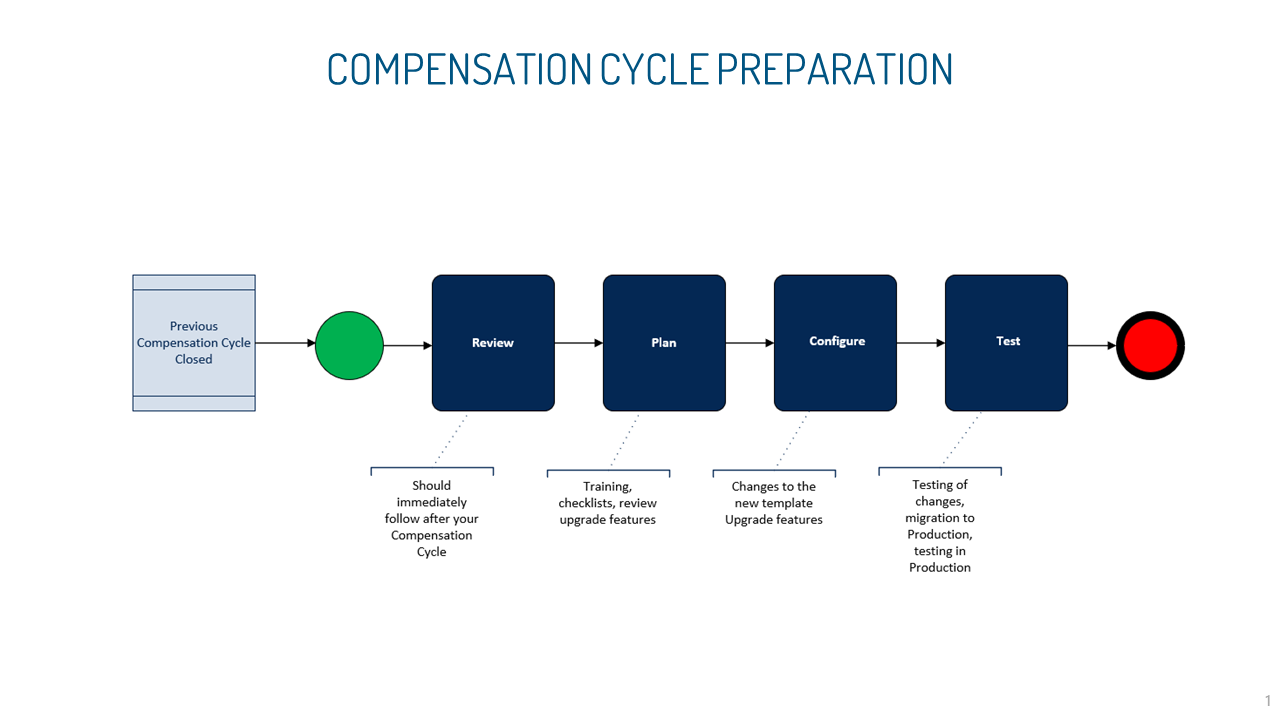
4 Key Steps to Prepare for Your Next Compensation Cycle
With SAP SuccessFactors.
When preparing for your next compensation cycle, there’s no shortage of things to consider. In this article, we reveal four key steps you must take to be fully compensation cycle ready in SAP SuccessFactors. We also take a closer look at how to make your compensation forms more concise and user-friendly, with a view to making your planning process even more efficient and easy to repeat year after year.
Your Guide to Comprehensive and Concise Compensation Planning Form Layout
Your compensation planning forms are an important part of preparing for each compensation cycle. Concise and intuitively laid-out forms can make a significant difference in how easy the planning process is to complete and replicate. Particularly, you’ll want to control the number of fields you use and consider the use of custom validations and executive review.
Taking Control of Your Fields
Try to keep to a minimal number of fields on your form to avoid unnecessary scrolling and ensure that planners only see the information that they need. To this end, it’s a good idea to include custom views instead of replicating data into compensation fields on the form—the user can then see the Employee Central data as a pop-up screen instead. You can also use field-based permissions to remove irrelevant fields from the planner’s view.
Overall, you don’t want to complicate the planner’s view with unnecessary information. One useful approach may be to try to logically group fields together using colored sections. Alternatively, you could use collapsing sections—identify the most useful fields to show when the section is collapsed and try to have the most relevant information to the left of the form with the less relevant to the right of the form. You can also look into enabling Help Text functionality for certain columns to explain how data is being populated without having to offer visibility to those columns.
Finally, you can make use of Employee Central’s new custom field eligibility functionality to grey out custom fields that shouldn’t be editable by certain groups of employees.
Embrace Custom Validations
Use custom validations to help improve the quality of planning and use the new field information text to explain what is expected from the compensation planner inputting into that field. You can also change the button and hover text to provide more information to the planners when they’re ready to move their form to the next step of the workflow.
Consider Using Executive Review in Your Workflow
Finally, keep the workflow as concise as possible and consider if executive review can be used instead. We always recommend that the first step of the workflow is a validation step with the compensation administrator so that they can ensure that all information is correct before sending the form to the compensation planners.
Always Create New Tables for Each Template
It's best practice to create new tables for your new template, for example, lookup tables, and currency conversion tables. This will prevent data from being overwritten in previous, completed templates (for audit purposes) and you can keep your historical tables for future reference. Name the tables so that you can easily identify which year they are relevant for example, 2023_CURRENCY_CONVERSION. When creating new lookup tables, remember to update the column formula to reference the new table name in Design Worksheet.
Preparing for the Next Cycle: Review, Plan, Configure, and Test

1) Review
When should you do it? During your current compensation cycle, and immediately after.
What does it involve? Your next cycle should begin before your current cycle ends. It’s never too early to start planning! You should make a list of issues and pain points as you go through your process so that you can address them when you begin your configuration updates. You should also arrange a ‘lessons learned’ session with a cross-section of users and review previously released enhancements as they may improve your process for the next year. Effective People can help with the release management review, providing you with a walk-through and demo of new functionality.
2) Plan
When should you do it? 4 to 5 months prior to the next compensation cycle.
What does it involve? You should start your planning after you’ve reviewed your last compensation process. You’ll want to consider whether you need training on new functionality and whether your administrators need additional training on the process or system. You should also create your checklists to ensure that all steps are carried out for the preparation of the next cycle.
3) Configure
When should you do it? 2 to 3 months prior to the next cycle.
What does it involve? You should now copy your template over to the new year and opt-in to any enhancement features that you’ve identified as relevant. Remember to update all your tables, formulas (if applicable), statements, and permissions.
4) Test
When should you do it? 2 to 3 months prior to the next cycle.
What does it involve? Involve as many people as possible in your testing activities. Download the standard SAP test plan/scripts to support your testing, you can find these on the SAP customer community.
You should always conduct at least one full end-to-end practice run in your test environment before migrating the template over to production. Once migrated, you should then conduct a dry run launch of the compensation forms. You’ll need to make some minor changes to do this:
Temporarily remove executive review permissions for roles other than the Compensation Administrator.
If you don’t have a validation step in the first step of the workflow, use an alternative test route map with only one step that is sent to the Compensation Administrator.
After testing is complete, reinstate executive review permissions.
Change the route map back to the original.
Purge the deleted test forms.
Once the forms are launched and ready for testing, export the data from executive review for all employees and then:
Conduct an audit of eligibility rules:
Are all eligible employees showing?
Are ineligible employees removed?
Conduct an audit of data:
Are the mappings to Employee Central correct?
Are lookup tables populating?
Are the guidelines correct?
Do the performance ratings appear?
Are the Salary Ranges showing the correct values?
Review budget information (filter by country/manager etc)
Are currency conversions calculating correctly?
Things to Remember Before the Live Process
Before you begin with your live process, remember there are other updates that may need considering first.
If you're using scheduled background jobs to update your worksheets, you'll need to create a new scheduled job that looks at your new template.
If you send template specific email notifications, these will need to be created for your new template.
If you use role-based permissions to restrict access based on a template, you'll need to update with your new template name e.g., Executive Review access.
If using start/end/due dates in the route map steps, these will need updating with your current year's process dates.
Field based permission and statements groups should be checked and verified that the members are still correct.
Change reports to reference your new template name.
Prepare with an Effective People Compensation Solution Review
Effective People can perform a solution review to help you identify potential areas of improvement in your compensation processes.
As part of the solution review, we’ll look at existing templates, review custom columns and formulas, review budget and guideline setup, and review lookup tables. An alternative to using lookup tables could be to use MDF objects and/or fields in Employee Central.
In this article, we’re only referring to the compensation portion of the solution review. However, Effective People can do a health check on all of the SuccessFactors modules you’ve implemented.
A full solution review includes:
a) Analysis
Perform a high-level review of the configuration.
Determine who is best suited to evaluate your compensation processes.
b) Deep Dive
Talk with team members about existing pain points.
Review processes in detail—in and outside of the system—and determine if manual processes can be incorporated into the system.
c) Evaluation
Document findings and recommendations.
Describe the next steps that must be taken.
d) Follow-Up
Schedule a session to review findings with the customer.
If needed, kick off the project to implement approved changes.
Get in touch with Effective People for assistance when preparing for your next compensation cycle.
About the author
Tom Fisker is a senior SAP SuccessFactors consultant with extensive experience in global implementations of the SAP SuccessFactors Compensation & Variable Pay module.
He has worked in various IT Delivery positions, including HR Application Expert, Support Consultant, and now as a Lead Implementation Consultant and other expert roles. Tom is a certified professional in Compensation & Variable Pay.
Get in Touch
Contact our expert team for assistance when preparing for your next compensation cycle.



